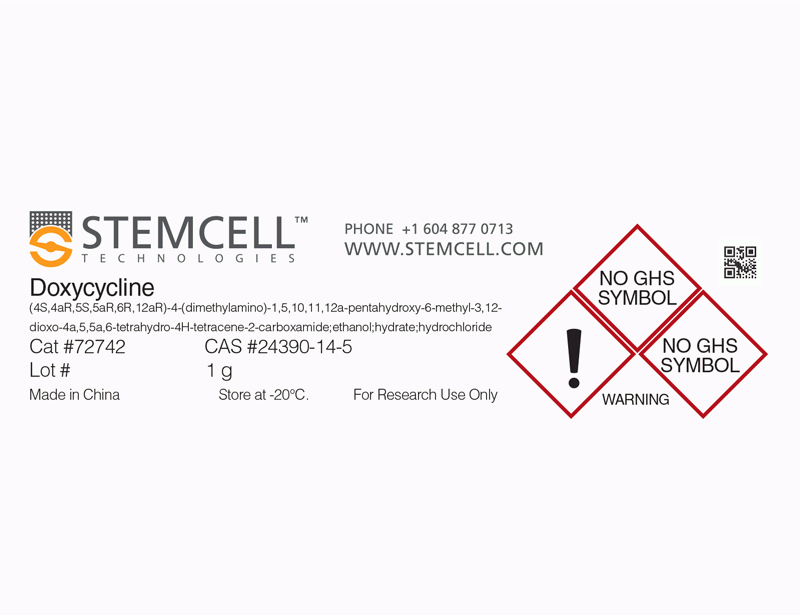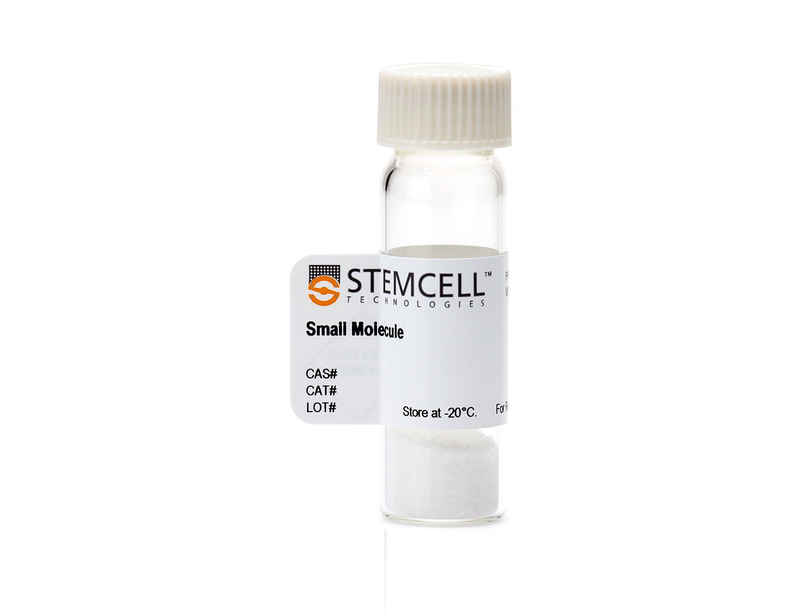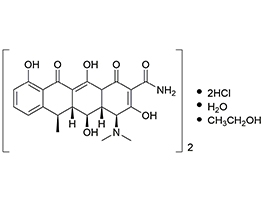概要
Doxycycline is a tetracycline-like antibiotic (Hicks et al.; Nau et al.; Solís García del Pozo & Solera; Steinhardt et al.). In genetic engineering, doxycycline is used as the regulator for inducible gene expression systems, whereby expression depends on either the presence (Tet-On) or absence (Tet-Off ) of doxycycline. Also, doxycycline inhibits certain matrix metalloproteinases (MMP), such as MMP-8 (Ki = 36 µM; Griffin et al.; Smith et al.). It only poorly inhibits MMP-1 and MMP-13 (Ki > 100 µM; Smith et al.). This product is supplied as the hyclate salt of the molecule.
CELL LINE DEVELOPMENT
· Used as the regulator for inducible gene expression in lentiviral infection and transgenic mouse models using the Tet-On or Tet-Off systems (Brambrink et al.; Carey et al.; Haenebalcke et al.; Hanna et al.; Hockemeyer et al.; Maherali et al.; Markoulaki et al.; Stadtfeld et al. 2008, 2010; Wernig et al.).
CELL LINE DEVELOPMENT
· Used as the regulator for inducible gene expression in lentiviral infection and transgenic mouse models using the Tet-On or Tet-Off systems (Brambrink et al.; Carey et al.; Haenebalcke et al.; Hanna et al.; Hockemeyer et al.; Maherali et al.; Markoulaki et al.; Stadtfeld et al. 2008, 2010; Wernig et al.).
技术资料
| Document Type | 产品名称 | Catalog # | Lot # | 语言 |
|---|---|---|---|---|
| Product Information Sheet | Doxycycline (Hyclate) | 72742 | All | English |
| Safety Data Sheet | Doxycycline (Hyclate) | 72742 | All | English |
数据及文献
Publications (18)
Proceedings of the National Academy of Sciences of the United States of America 2013 MAR
Simple piggyBac transposon-based mammalian cell expression system for inducible protein production.
Abstract
Abstract
Reported here is a piggyBac transposon-based expression system for the generation of doxycycline-inducible, stably transfected mammalian cell cultures for large-scale protein production. The system works with commonly used adherent and suspension-adapted mammalian cell lines and requires only a single transfection step. Moreover, the high uniform expression levels observed among clones allow for the use of stable bulk cell cultures, thereby eliminating time-consuming cloning steps. Under continuous doxycycline induction, protein expression levels have been shown to be stable for at least 2 mo in the absence of drug selection. The high efficiency of the system also allows for the generation of stable bulk cell cultures in 96-well format, a capability leading to the possibility of generating stable cell cultures for entire families of membrane or secreted proteins. Finally, we demonstrate the utility of the system through the large-scale production (140-750 mg scale) of an endoplasmic reticulum-resident fucosyltransferase and two potential anticancer protein therapeutic agents.
Cell reports 2013 FEB
The ROSA26-iPSC mouse: a conditional, inducible, and exchangeable resource for studying cellular (De)differentiation.
Abstract
Abstract
Control of cellular (de)differentiation in a temporal, cell-specific, and exchangeable manner is of paramount importance in the field of reprogramming. Here, we have generated and characterized a mouse strain that allows iPSC generation through the Cre/loxP conditional and doxycycline/rtTA-controlled inducible expression of the OSKM reprogramming factors entirely from within the ROSA26 locus. After reprogramming, these factors can be replaced by genes of interest-for example, to enhance lineage-directed differentiation-with the use of a trap-coupled RMCE reaction. We show that, similar to ESCs, Dox-controlled expression of the cardiac transcriptional regulator Mesp1 together with Wnt inhibition enhances the generation of functional cardiomyocytes upon in vitro differentiation of such RMCE-retargeted iPSCs. This ROSA26-iPSC mouse model is therefore an excellent tool for studying both cellular reprogramming and lineage-directed differentiation factors from the same locus and will greatly facilitate the identification and ease of functional characterization of the genetic/epigenetic determinants involved in these complex processes.
Intensive care medicine 2012 JUL
An overview of anthrax infection including the recently identified form of disease in injection drug users.
Abstract
Abstract
PURPOSE Bacillus anthracis infection (anthrax) can be highly lethal. Two recent outbreaks related to contaminated mail in the USA and heroin in the UK and Europe and its potential as a bioterrorist weapon have greatly increased concerns over anthrax in the developed world. METHODS This review summarizes the microbiology, pathogenesis, diagnosis, and management of anthrax. RESULTS AND CONCLUSIONS Anthrax, a gram-positive bacterium, has typically been associated with three forms of infection: cutaneous, gastrointestinal, and inhalational. However, the anthrax outbreak among injection drug users has emphasized the importance of what is now considered a fourth disease form (i.e., injectional anthrax) that is characterized by severe soft tissue infection. While cutaneous anthrax is most common, its early stages are distinct and prompt appropriate treatment commonly produces a good outcome. However, early symptoms with the other three disease forms can be nonspecific and mistaken for less lethal conditions. As a result, patients with gastrointestinal, inhalational, or injectional anthrax may have advanced infection at presentation that can be highly lethal. Once anthrax is suspected, the diagnosis can usually be made with gram stain and culture from blood or tissue followed by confirmatory testing (e.g., PCR). While antibiotics are the mainstay of anthrax treatment, use of adjunctive therapies such as anthrax toxin antagonists are a consideration. Prompt surgical therapy appears to be important for successful management of injectional anthrax.
PloS one 2012 JAN
Systematic review and meta-analysis of randomized clinical trials in the treatment of human brucellosis.
Abstract
Abstract
BACKGROUND Brucellosis is a persistent health problem in many developing countries throughout the world, and the search for simple and effective treatment continues to be of great importance. METHODS AND FINDINGS A search was conducted in MEDLINE and in the Cochrane Central Register of Controlled Trials (CENTRAL). Clinical trials published from 1985 to present that assess different antimicrobial regimens in cases of documented acute uncomplicated human brucellosis were included. The primary outcomes were relapse, therapeutic failure, combined variable of relapse and therapeutic failure, and adverse effect rates. A meta-analysis with a fixed effect model was performed and odds ratio with 95% confidence intervals were calculated. A random effect model was used when significant heterogeneity between studies was verified. Comparison of combined doxycycline and rifampicin with a combination of doxycycline and streptomycin favors the latter regimen (OR = 3.17; CI95% = 2.05-4.91). There were no significant differences between combined doxycycline-streptomycin and combined doxycycline-gentamicin (OR = 1.89; CI95% = 0.81-4.39). Treatment with rifampicin and quinolones was similar to combined doxycycline-rifampicin (OR = 1.23; CI95% = 0.63-2.40). Only one study assessed triple therapy with aminoglycoside-doxycycline-rifampicin and only included patients with uncomplicated brucellosis. Thus this approach cannot be considered the therapy of choice until further studies have been performed. Combined doxycycline/co-trimoxazole or doxycycline monotherapy could represent a cost-effective alternative in certain patient groups, and further studies are needed in the future. CONCLUSIONS Although the preferred treatment in uncomplicated human brucellosis is doxycycline-aminoglycoside combination, other treatments based on oral regimens or monotherapy should not be rejected until they are better studied. Triple therapy should not be considered the current treatment of choice.
Pharmacological research 2011 FEB
Tetracycline compounds with non-antimicrobial organ protective properties: possible mechanisms of action.
Abstract
Abstract
Tetracyclines were developed as a result of the screening of soil samples for antibiotics. The first(t) of these compounds, chlortetracycline, was introduced in 1947. Tetracyclines were found to be highly effective against various pathogens including rickettsiae, as well as both gram-positive and gram-negative bacteria, thus becoming the first class of broad-spectrum antibiotics. Many other interesting properties, unrelated to their antibiotic activity, have been identified for tetracyclines which have led to widely divergent experimental and clinical uses. For example, tetracyclines are also an effective anti-malarial drug. Minocycline, which can readily cross cell membranes, is known to be a potent anti-apoptotic agent. Another tetracycline, doxycycline is known to exert anti-protease activities. Doxycycline can inhibit matrix metalloproteinases which contribute to tissue destruction activities in diseases such as periodontitis. A large body of literature has provided additional evidence for the beneficial" actions of tetracyclines�
The American journal of tropical medicine and hygiene 2011 DEC
Review: Malaria chemoprophylaxis for travelers to Latin America.
Abstract
Abstract
Because of recent declining malaria transmission in Latin America, some authorities have recommended against chemoprophylaxis for most travelers to this region. However, the predominant parasite species in Latin America, Plasmodium vivax, can form hypnozoites sequestered in the liver, causing malaria relapses. Additionally, new evidence shows the potential severity of vivax infections, warranting continued consideration of prophylaxis for travel to Latin America. Individualized travel risk assessments are recommended and should consider travel locations, type, length, and season, as well as probability of itinerary changes. Travel recommendations might include no precautions, mosquito avoidance only, or mosquito avoidance and chemoprophylaxis. There are a range of good options for chemoprophylaxis in Latin America, including atovaquone-proguanil, doxycycline, mefloquine, and--in selected areas--chloroquine. Primaquine should be strongly considered for nonpregnant, G6PD-nondeficient patients traveling to vivax-endemic areas of Latin America, and it has the added benefit of being the only drug to protect against malaria relapses.

 网站首页
网站首页




